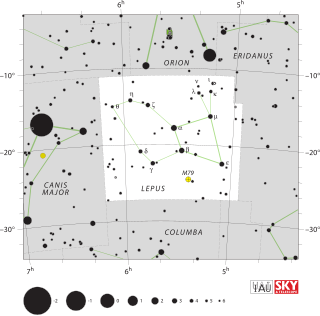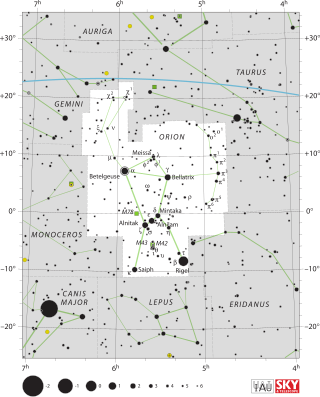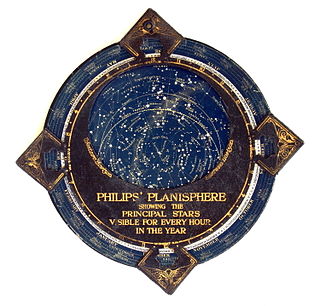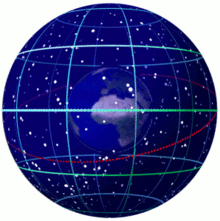
Carina is a constellation in the southern sky. Its name is Latin for the keel of a ship, and it was the southern foundation of the larger constellation of Argo Navis until it was divided into three pieces, the other two being Puppis, and Vela.

In astronomy, declination is one of the two angles that locate a point on the celestial sphere in the equatorial coordinate system, the other being hour angle. The declination angle is measured north (positive) or south (negative) of the celestial equator, along the hour circle passing through the point in question.

Lepus is a constellation lying just south of the celestial equator. Its name is Latin for hare. It is located below—immediately south—of Orion, and is sometimes represented as a hare being chased by Orion or by Orion's hunting dogs.

Octans is a faint constellation located in the deep Southern Sky. Its name is Latin for the eighth part of a circle, but it is named after the octant, a navigational instrument. Devised by French astronomer Nicolas Louis de Lacaille in 1752, Octans remains one of the 88 modern constellations. The southern celestial pole is located within the boundaries of Octans.

Right ascension is the angular distance of a particular point measured eastward along the celestial equator from the Sun at the March equinox to the point in question above the Earth. When paired with declination, these astronomical coordinates specify the location of a point on the celestial sphere in the equatorial coordinate system.

Taurus is one of the constellations of the zodiac and is located in the northern celestial hemisphere. Taurus is a large and prominent constellation in the Northern Hemisphere's winter sky. It is one of the oldest constellations, dating back to the Early Bronze Age at least, when it marked the location of the Sun during the spring equinox. Its importance to the agricultural calendar influenced various bull figures in the mythologies of Ancient Sumer, Akkad, Assyria, Babylon, Egypt, Greece, and Rome. Its old astronomical symbol is (♉︎), which resembles a bull's head.

In astronomy and navigation, the celestial sphere is an abstract sphere that has an arbitrarily large radius and is concentric to Earth. All objects in the sky can be conceived as being projected upon the inner surface of the celestial sphere, which may be centered on Earth or the observer. If centered on the observer, half of the sphere would resemble a hemispherical screen over the observing location.

The north and south celestial poles are the two points in the sky where Earth's axis of rotation, indefinitely extended, intersects the celestial sphere. The north and south celestial poles appear permanently directly overhead to observers at Earth's North Pole and South Pole, respectively. As Earth spins on its axis, the two celestial poles remain fixed in the sky, and all other celestial points appear to rotate around them, completing one circuit per day.

Cancer is one of the twelve constellations of the zodiac and is located in the Northern celestial hemisphere. Its old astronomical symbol is (♋︎). Its name is Latin for crab and it is commonly represented as one. Cancer is a medium-size constellation with an area of 506 square degrees and its stars are rather faint, its brightest star Beta Cancri having an apparent magnitude of 3.5. It contains ten stars with known planets, including 55 Cancri, which has five: one super-earth and four gas giants, one of which is in the habitable zone and as such has expected temperatures similar to Earth. At the (angular) heart of this sector of our celestial sphere is Praesepe, one of the closest open clusters to Earth and a popular target for amateur astronomers.

A circumpolar star is a star that, as viewed from a given latitude on Earth, never sets below the horizon due to its apparent proximity to one of the celestial poles. Circumpolar stars are therefore visible from said location toward the nearest pole for the entire night on every night of the year. Others are called seasonal stars.

The celestial equator is the great circle of the imaginary celestial sphere on the same plane as the equator of Earth. By extension, it is also a plane of reference in the equatorial coordinate system. In other words, the celestial equator is an abstract projection of the terrestrial equator into outer space. Due to Earth's axial tilt, the celestial equator is currently inclined by about 23.44° with respect to the ecliptic, but has varied from about 22.0° to 24.5° over the past 5 million years due to perturbation from other planets.

Orion is a prominent set of stars visible during winter in the northern celestial hemisphere. It is one of the 88 modern constellations; it was among the 48 constellations listed by the 2nd-century astronomer Ptolemy. It is named for a hunter in Greek mythology.

In astronomy, a planisphere is a star chart analog computing instrument in the form of two adjustable disks that rotate on a common pivot. It can be adjusted to display the visible stars for any time and date. It is an instrument to assist in learning how to recognize stars and constellations. The astrolabe, an instrument that has its origins in Hellenistic astronomy, is a predecessor of the modern planisphere. The term planisphere contrasts with armillary sphere, where the celestial sphere is represented by a three-dimensional framework of rings.

A pole star is a visible star that is approximately aligned with the axis of rotation of an astronomical body; that is, a star whose apparent position is close to one of the celestial poles. On Earth, a pole star would lie directly overhead when viewed from the North or the South Pole.

Spherical astronomy, or positional astronomy, is a branch of observational astronomy used to locate astronomical objects on the celestial sphere, as seen at a particular date, time, and location on Earth. It relies on the mathematical methods of spherical trigonometry and the measurements of astrometry.

The Winter Hexagon or Winter Circle/Oval is an asterism appearing to be in the form of a hexagon with vertices at Rigel, Aldebaran, Capella, Pollux, Procyon, and Sirius. It is mostly upon the Northern Hemisphere's celestial sphere. On most locations on Earth, this asterism is visible in the evening sky at the equator from approximately December to June, and in the morning sky from July to the end of November, while in the evenings on the northern hemisphere it is less months visible between December and June, and on the southern hemisphere less months between July and November. In the tropics and southern hemisphere, this can be extended with the bright star Canopus in the south.

Daytime as observed on Earth is the period of the day during which a given location experiences natural illumination from direct sunlight. Daytime occurs when the Sun appears above the local horizon, that is, anywhere on the globe's hemisphere facing the Sun. In direct sunlight the movement of the sun can be recorded and observed using a sundial that casts a shadow that slowly moves during the day. Other planets and natural satellites that rotate relative to a luminous primary body, such as a local star, also experience daytime, but this article primarily discusses daytime on Earth.

Constellation families are collections of constellations sharing some defining characteristic, such as proximity on the celestial sphere, common historical origin, or common mythological theme. In the Western tradition, most of the northern constellations stem from Ptolemy's list in the Almagest, and most of the far southern constellations were introduced by sailors and astronomers who traveled to the south in the 16th to 18th centuries. Separate traditions arose in India and China.

The northern celestial hemisphere, also called the Northern Sky, is the northern half of the celestial sphere; that is, it lies north of the celestial equator. This arbitrary sphere appears to rotate westward around a polar axis due to Earth's rotation.



















